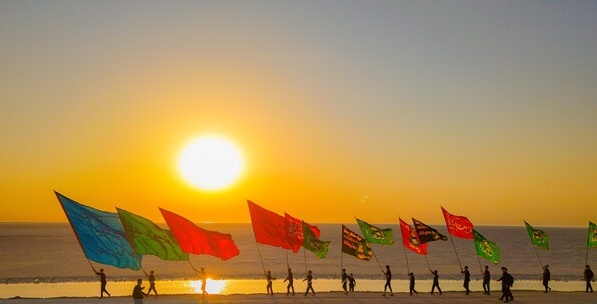SAEDNEWS: The Arbaeen Pilgrimage, marking 40 days after the martyrdom anniversary of Imam Hussein ibn Ali (AS), draws tens of millions from around the globe, making it the largest peaceful assembly in the world.

Every year in the month of Safar — the second month of the Islamic lunar calendar — the barren deserts of Iraq turn into the stage of humanity’s greatest expression of love and solidarity. The Arbaeen Pilgrimage, marking 40 days after the martyrdom anniversary of Imam Hussein ibn Ali (AS), draws tens of millions from around the globe, making it the largest peaceful assembly in the world.
Imam Hussein, the third Shia Imam and grandson of Prophet Muhammad (PBUH), was martyred in 680 AD during the Battle of Karbala. Refusing to pledge allegiance to Yazid, the ruler of the time, Imam Hussein stood against tyranny despite facing an army of 40,000 with only a small band of family and loyal companions. His martyrdom — alongside his infant son and loved ones — became a timeless symbol of courage, justice, and sacrifice.
From Najaf to Karbala: A walk of faith
The Arbaeen journey often begins in the holy city of Najaf, where pilgrims visit the shrine of Imam Ali (AS), the father of Imam Hussein and the first Imam of Shia Muslims. From there, they embark on a 50-mile (80-kilometer) trek toward Karbala. The walk takes several days, cutting through open desert under Iraq’s intense sun. Yet, regardless of age, health, or nationality, pilgrims persevere — united by their devotion.

Along the route, thousands of Mawkibs (volunteer service stations) line the road, offering free food, water, medical aid, and rest areas. Hospitality knows no bounds; even the poorest give what they can — from home-cooked meals to a simple foot massage for weary travelers. Iraqis, Iranians, and people from dozens of other nations host these stations, embodying Imam Hussein’s values of generosity and selflessness.
The meaning behind Arbaeen
In Arabic, “Arbaeen” means “forty,” signifying the end of the traditional 40-day mourning period. For Shia Muslims, the pilgrimage is more than a religious ritual — it is a pledge to uphold the values Imam Hussein died defending. The chant “Labaik ya Hussein” (“I am here, O Hussein”) echoes along the road, symbolizing the pilgrims’ readiness to continue his mission of truth and justice.

A global message of unity
What sets Arbaeen apart is its inclusivity. Visitors of all faiths — Shia, Sunni, Christian, and even atheists — walk together, sharing meals and stories. National flags from every continent wave in unison, sending a powerful message: Imam Hussein’s legacy belongs to all humanity.
For many, Arbaeen is also a time of learning and dialogue. Pilgrims exchange ideas, discuss social and political issues, and strengthen bonds across cultures. It’s a living example of peaceful coexistence in today's world.
Arrival in Karbala
For the exhausted travelers, the sight of Karbala’s golden domes is overwhelming. Tears flow as they enter Bayn al-Haramayn, the space between the shrines of Imam Hussein and his brother, Hazrat Abbas (AS). Here, they join mass mourning ceremonies, recite prayers, and perform acts of charity — each pilgrim deepening their spiritual connection.

Why it matters
The Arbaeen Pilgrimage is not just the world’s largest annual gathering — it’s a moving display of selflessness, unity, and resistance against oppression. In the words of Prophet Muhammad (PBUH): “Hussein is from me, and I am from Hussein. Allah loves those who love Hussein.”
As millions return home, they carry with them not only the memories of a sacred journey but also a renewed commitment to live by the principles Imam Hussein gave his life to defend.

